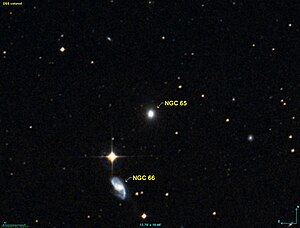NGC 65
| Galaxy NGC 65 |
|
|---|---|

|
|
| NGC 66 & NGC 65 | |
| AladinLite | |
| Constellation | whale |
|
Position equinox : J2000.0 , epoch : J2000.0 |
|
| Right ascension | 00 h 18 m 58.7 s |
| declination | -22 ° 52 ′ 49 ″ |
| Appearance | |
| Morphological type | SAB (rs) 0-: |
| Brightness (visual) | 13.4 mag |
| Brightness (B-band) | 14.4 mag |
| Angular expansion | 1 ′ × 0.8 ′ |
| Position angle | 5 ° |
| Surface brightness | 13.2 mag / arcmin² |
| Physical data | |
| Redshift | 0.024327 ± 0.000160 |
| Radial velocity | 7293 ± 48 km / s |
|
Stroke distance v rad / H 0 |
(327 ± 23) x 10 6 ly (100.2 ± 7.0) Mpc |
| history | |
| discovery | Frank Muller |
| Discovery date | 1886 |
| Catalog names | |
| NGC 65 • PGC 1229 • ESO 473-010 • MCG -04-02-001 • 2MASX J00185872-2252491 • SGC 001628-2309.5 • GALEX ASC J001858.91-225248.1 • LDCE 16 NED001 | |
NGC 65 is a Hubble-type E / SB0 elliptical galaxy in the constellation Whale south of the celestial equator . It is estimated to be 327 million light years away from the Milky Way and has a diameter of around 95,000 ly.
In the same area of the sky are the galaxies NGC 66 and NGC 77 , among others .
The object was discovered in 1886 by the astronomer Frank Muller .
